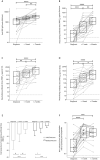Dynamics of viral shedding during ancestral or Omicron BA.1 SARS-CoV-2 infection and enhancement of pre-existing immunity during breakthrough infections
- PMID: 36098494
- PMCID: PMC9621261
- DOI: 10.1080/22221751.2022.2122578
Dynamics of viral shedding during ancestral or Omicron BA.1 SARS-CoV-2 infection and enhancement of pre-existing immunity during breakthrough infections
Abstract
Omicron variant is circulating in the presence of a globally acquired immunity unlike the ancestral SARS-CoV-2 isolate. Herein, we investigated the normalized viral load dynamics and viral culture status in 44 fully vaccinated healthcare workers (HCWs) infected with the Omicron BA.1 variant. Viral load dynamics of 38 unvaccinated HCWs infected with the 20A variant during the first pandemic wave was also studied. We then explored the impact of Omicron infection on pre-existing immunity assessing anti-RBD IgG levels, neutralizing antibody titres against 19A, Delta and Omicron isolates, as well as IFN-γ release following cell stimulation with SARS-CoV-2 peptides. We reported that two weeks after diagnosis a greater proportion of HCWs infected with 20A (78.9%, 15/19) than with Omicron BA.1 (44.7%, 17/38; p = 0.02) were still positive by RT-qPCR. We found that Omicron breakthrough infections led to an overall enhancement of vaccine-induced humoral and cellular immunity as soon as a median [interquartile range] of 8 [7-9] days post symptom onset. Among samples with similar high viral loads, non-culturable samples exhibited higher neutralizing antibody titres and anti-RBD IgG levels than culturable samples. Additionally, Omicron infection led to an enhancement of antibodies neutralization capacity against other SARS-CoV-2 isolates. Taken together, the results suggest that Omicron BA.1 vaccine breakthrough infection is associated with a faster viral clearance than that of the ancestral SARS-CoV-2, in addition this new variant leads to a rapid enhancement of the humoral response against multiple SARS-CoV-2 variants, and of the cellular response.
Keywords: Omicron; SARS-CoV-2; infectiousness; vaccine-immunity; viral culture; viral shedding.
Conflict of interest statement
K.B.-P., G.O., V.C., L.G. and C.C. are bioMérieux employees. A.B. received a grant from bioMérieux and served as consultant for bioMérieux for work and research not related to this manuscript. S.T.-A. received a research grant from bioMérieux concerning previous works not related to this manuscript. The other authors have no relevant affiliations or financial involvement with any organization or entity with a financial interest in or financial conflict with the subject matter or materials discussed in the manuscript.
Figures




References
-
- WHO . Tracking SARS-CoV-2 variants. [cited 2002 Apr 1]. Available from: https://www.who.int/health-topics/nipah-virus-infection/tracking-SARS-Co...
-
- Lyngse FP, Mortensen LH, Denwood MJ, et al. SARS-CoV-2 Omicron VOC transmission in Danish households. medRxiv 2021;2021.12.27.21268278. DOI:10.1101/2021.12.27.21268278 - DOI
MeSH terms
Substances
Supplementary concepts
LinkOut - more resources
Full Text Sources
Other Literature Sources
Medical
Miscellaneous
